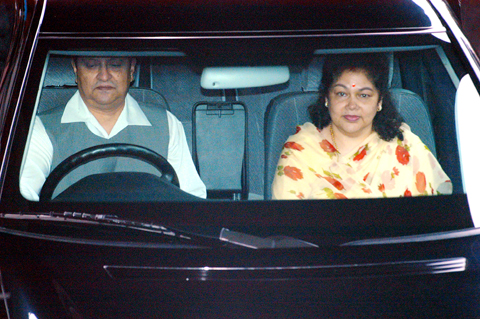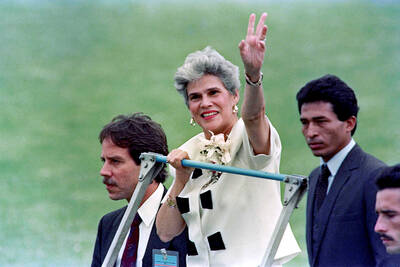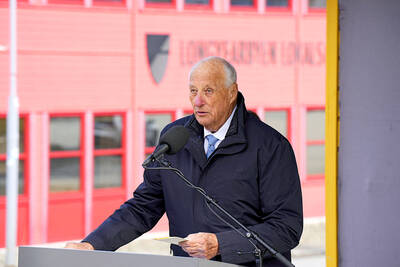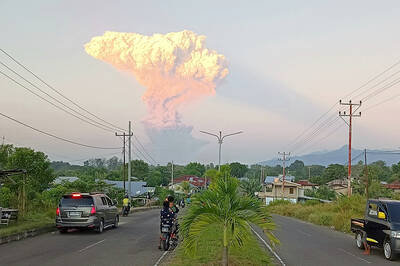It was a surprising sight in a land grown accustomed to surprises: the king at the wheel of a Mercedes-Benz, driving himself and his queen through the crowded streets of Kathmandu.
“He was in the front seat! In traffic!” said Krishna Chetri, a 56-year-old shop owner.
“Where’s the majesty?” he asked. “This is something I never would have believed.”

PHOTO: AP
In this Himalayan land, the Shah dynasty of kings reputed to be reincarnated Hindu gods is being pushed to possible extinction by the fallout from a decade-long communist rebellion and King Gyanendra’s own autocratic ways.
Nepal votes on Thursday for an assembly that will rewrite its Constitution, the latest effort to transform a troubled, near-medieval land into a modern democracy. And the assembly’s first order of business: eliminating the monarchy.
“This king has done too much harm. He’s shown us that we don’t need kings,” said Krishna Prashad Sitaula, a Cabinet minister and a leader of the centrist Nepali Congress party who helped negotiate the peace deal with the rebels, known as the Maoists.
Not everyone is so sure.
“This king lost the people’s favor,” said Ram Shresthra Prasad, a 42-year-old priest at the Pashupatinath Temple, the clamorous shrine to which Gyanendra drove last month.
But “this talk of a secular republic is ignorant,” he said.
“Our kings created Nepal. They protect our Hindu religion. The kings are the symbol of Nepal.”
Yet in many demonstrative ways, Gyanendra’s 269-year-old Shah dynasty has reached the end of the line.
In January, Nepal’s interim parliament formally declared the country a secular republic. Gyanendra’s portrait has disappeared from shop walls and the currency “Royal” has been removed from the name of the army and national airline. References to the king are gone from the national anthem.
Gyanendra has also endured other indignities. His US$3.1 million annual allowance and 10 of the family’s palaces were taken away, as were the queen’s beauticians and about half his ceremonial guard.
Gyanendra can probably afford the losses. Before assuming the throne, he was known as a hardheaded businessman with interests in tourism, tea and tobacco.
He can also afford to hire his own driver and did his own driving to show that he is at the public’s disposal in what ever role it chooses, said a palace official, who spoke anonymously because the government has told Gyanendra not to make public statements.
Gyanendra’s aides and supporters are hoping that the fractious political elite will be unable to agree on dumping him and will also head public opinion, which seems far from unanimous about abolishing the monarchy.
A survey conducted in January by Interdisciplinary Analysts, a private firm, found 49 percent of Nepalis favored retaining the monarchy and 12 percent undecided.
But Gyanendra, personally, fared far worse. The 3,000 people questioned gave him an average popularity rating of 2.8 on a scale of 1 to 8, the lowest of any major political figure. The poll gave a margin of error of 2 percentage points.
Gyanendra’s dynasty dates back to 1769, when a regional ruler conquered Kathmandu and united Nepal.
The mystique of the royal line he founded was pierced in 2001 by a palace bloodbath in which a gunman, allegedly the crown prince, gunned down late King Birendra and much of the royal family before killing himself. Gyanendra, the dead king’s older brother, then took the throne.
Four years later, with armed rebellion raging, Gyanendra dismissed an elected government and vowed to crush the Maoist rebellion himself. He failed, and his popularity plummeted. By April 2006, widespread unrest had forced the king to restore democracy.
Soon after, the Maoists ended their fight. And last year, in a deal that paved the way for Thursday’s elections, they agreed with the major political parties that after the vote no man should wear the bejeweled Nepalese crown of yak hair and peacock feathers.

Former Nicaraguan president Violeta Chamorro, who brought peace to Nicaragua after years of war and was the first woman elected president in the Americas, died on Saturday at the age of 95, her family said. Chamorro, who ruled the poor Central American country from 1990 to 1997, “died in peace, surrounded by the affection and love of her children,” said a statement issued by her four children. As president, Chamorro ended a civil war that had raged for much of the 1980s as US-backed rebels known as the “Contras” fought the leftist Sandinista government. That conflict made Nicaragua one of

BOMBARDMENT: Moscow sent more than 440 drones and 32 missiles, Volodymyr Zelenskiy said, in ‘one of the most terrifying strikes’ on the capital in recent months A nighttime Russian missile and drone bombardment of Ukraine killed at least 15 people and injured 116 while they slept in their homes, local officials said yesterday, with the main barrage centering on the capital, Kyiv. Kyiv City Military Administration head Tymur Tkachenko said 14 people were killed and 99 were injured as explosions echoed across the city for hours during the night. The bombardment demolished a nine-story residential building, destroying dozens of apartments. Emergency workers were at the scene to rescue people from under the rubble. Russia flung more than 440 drones and 32 missiles at Ukraine, Ukrainian President Volodymyr Zelenskiy

COMPETITION: The US and Russia make up about 90 percent of the world stockpile and are adding new versions, while China’s nuclear force is steadily rising, SIPRI said Most of the world’s nuclear-armed states continued to modernize their arsenals last year, setting the stage for a new nuclear arms race, the Stockholm International Peace Research Institute (SIPRI) said yesterday. Nuclear powers including the US and Russia — which account for about 90 percent of the world’s stockpile — had spent time last year “upgrading existing weapons and adding newer versions,” researchers said. Since the end of the Cold War, old warheads have generally been dismantled quicker than new ones have been deployed, resulting in a decrease in the overall number of warheads. However, SIPRI said that the trend was likely

Indonesia’s Mount Lewotobi Laki-Laki yesterday erupted again with giant ash and smoke plumes after forcing evacuations of villages and flight cancelations, including to and from the resort island of Bali. Several eruptions sent ash up to 5km into the sky on Tuesday evening to yesterday afternoon. An eruption on Tuesday afternoon sent thick, gray clouds 10km into the sky that expanded into a mushroom-shaped ash cloud visible as much as 150km kilometers away. The eruption alert was raised on Tuesday to the highest level and the danger zone where people are recommended to leave was expanded to 8km from the crater. Officers also